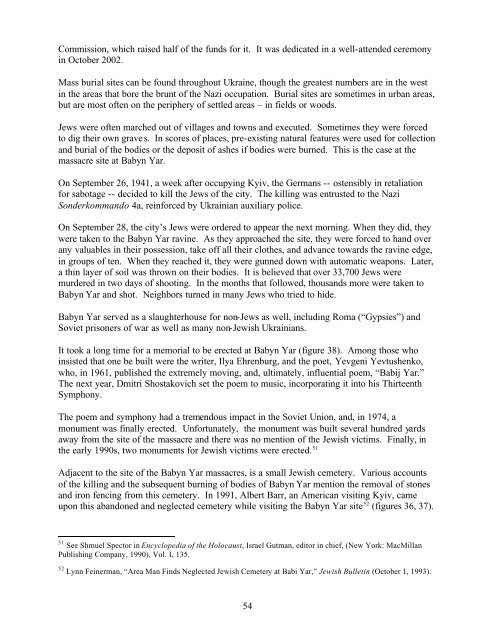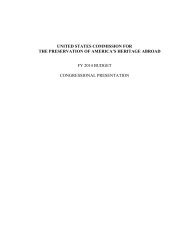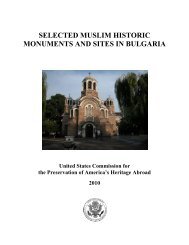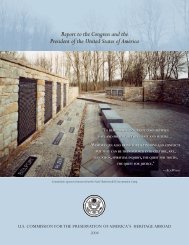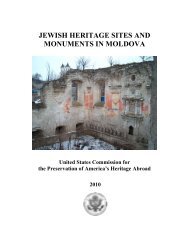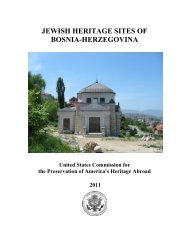jewish cemeteries, synagogues, and mass grave sites in ukraine
jewish cemeteries, synagogues, and mass grave sites in ukraine
jewish cemeteries, synagogues, and mass grave sites in ukraine
Create successful ePaper yourself
Turn your PDF publications into a flip-book with our unique Google optimized e-Paper software.
Commission, which raised half of the funds for it. It was dedicated <strong>in</strong> a well-attended ceremony<br />
<strong>in</strong> October 2002.<br />
Mass burial <strong>sites</strong> can be found throughout Ukra<strong>in</strong>e, though the greatest numbers are <strong>in</strong> the west<br />
<strong>in</strong> the areas that bore the brunt of the Nazi occupation. Burial <strong>sites</strong> are sometimes <strong>in</strong> urban areas,<br />
but are most often on the periphery of settled areas – <strong>in</strong> fields or woods.<br />
Jews were often marched out of villages <strong>and</strong> towns <strong>and</strong> executed. Sometimes they were forced<br />
to dig their own <strong>grave</strong>s. In scores of places, pre-exist<strong>in</strong>g natural features were used for collection<br />
<strong>and</strong> burial of the bodies or the deposit of ashes if bodies were burned. This is the case at the<br />
<strong>mass</strong>acre site at Babyn Yar.<br />
On September 26, 1941, a week after occupy<strong>in</strong>g Kyiv, the Germans -- ostensibly <strong>in</strong> retaliation<br />
for sabotage -- decided to kill the Jews of the city. The kill<strong>in</strong>g was entrusted to the Nazi<br />
Sonderkomm<strong>and</strong>o 4a, re<strong>in</strong>forced by Ukra<strong>in</strong>ian auxiliary police.<br />
On September 28, the city’s Jews were ordered to appear the next morn<strong>in</strong>g. When they did, they<br />
were taken to the Babyn Yar rav<strong>in</strong>e. As they approached the site, they were forced to h<strong>and</strong> over<br />
any valuables <strong>in</strong> their possession, take off all their clothes, <strong>and</strong> advance towards the rav<strong>in</strong>e edge,<br />
<strong>in</strong> groups of ten. When they reached it, they were gunned down with automatic weapons. Later,<br />
a th<strong>in</strong> layer of soil was thrown on their bodies. It is believed that over 33,700 Jews were<br />
murdered <strong>in</strong> two days of shoot<strong>in</strong>g. In the months that followed, thous<strong>and</strong>s more were taken to<br />
Babyn Yar <strong>and</strong> shot. Neighbors turned <strong>in</strong> many Jews who tried to hide.<br />
Babyn Yar served as a slaughterhouse for non-Jews as well, <strong>in</strong>clud<strong>in</strong>g Roma (“Gypsies”) <strong>and</strong><br />
Soviet prisoners of war as well as many non-Jewish Ukra<strong>in</strong>ians.<br />
It took a long time for a memorial to be erected at Babyn Yar (figure 38). Among those who<br />
<strong>in</strong>sisted that one be built were the writer, Ilya Ehrenburg, <strong>and</strong> the poet, Yevgeni Yevtushenko,<br />
who, <strong>in</strong> 1961, published the extremely mov<strong>in</strong>g, <strong>and</strong>, ultimately, <strong>in</strong>fluential poem, “Babij Yar.”<br />
The next year, Dmitri Shostakovich set the poem to music, <strong>in</strong>corporat<strong>in</strong>g it <strong>in</strong>to his Thirteenth<br />
Symphony.<br />
The poem <strong>and</strong> symphony had a tremendous impact <strong>in</strong> the Soviet Union, <strong>and</strong>, <strong>in</strong> 1974, a<br />
monument was f<strong>in</strong>ally erected. Unfortunately, the monument was built several hundred yards<br />
away from the site of the <strong>mass</strong>acre <strong>and</strong> there was no mention of the Jewish victims. F<strong>in</strong>ally, <strong>in</strong><br />
the early 1990s, two monuments for Jewish victims were erected. 51<br />
Adjacent to the site of the Babyn Yar <strong>mass</strong>acres, is a small Jewish cemetery. Various accounts<br />
of the kill<strong>in</strong>g <strong>and</strong> the subsequent burn<strong>in</strong>g of bodies of Babyn Yar mention the removal of stones<br />
<strong>and</strong> iron fenc<strong>in</strong>g from this cemetery. In 1991, Albert Barr, an American visit<strong>in</strong>g Kyiv, came<br />
upon this ab<strong>and</strong>oned <strong>and</strong> neglected cemetery while visit<strong>in</strong>g the Babyn Yar site 52 (figures 36, 37).<br />
51 See Shmuel Spector <strong>in</strong> Encyclopedia of the Holocaust, Israel Gutman, editor <strong>in</strong> chief, (New York: MacMillan<br />
Publish<strong>in</strong>g Company, 1990), Vol. I, 135.<br />
52 Lynn Fe<strong>in</strong>erman, “Area Man F<strong>in</strong>ds Neglected Jewish Cemetery at Babi Yar,” Jewish Bullet<strong>in</strong> (October 1, 1993).<br />
54


